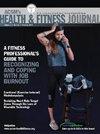基于情感的运动处方:一个时机已经成熟的想法?
IF 1.8
4区 医学
Q3 SPORT SCIENCES
引用次数: 51
摘要
1. 永远记住任何锻炼或体育活动计划的“主要目标”应该是什么:鼓励终身活动。短期适应(例如,体重减轻,健康增加)应被视为次要的。2. 在允许客户选择自己的节奏和为他们做决定之间,更倾向于前者,但要注意极端的反应(太低,太高)。设置一个比客户选择的强度稍高的强度可能会降低锻炼的乐趣。3.指导客户找到一种让他们“感觉良好”的节奏是一种很好的个性化方法。这个过程可以通过要求他们在一个称为“感觉量表”的评分量表上保持至少+3来辅助,其中+5被标记为“非常好”,+3被标记为“好”,+1被标记为“相当好”,- 1被标记为“相当差”,- 3被标记为“差”,- 5被标记为“非常差”。”4。就像你系统地监测心率和感知劳累一样,让评估快乐/不快乐的反应成为你练习的一部分。本文章由计算机程序翻译,如有差异,请以英文原文为准。
AFFECT-BASED EXERCISE PRESCRIPTION: An Idea Whose Time Has Come?
1. Always remember what the “prime objective” of any exercise or physical activity plan should be: encourage lifelong activity. Short-term adaptations (e.g., weight loss, fitness gains) shouldbeconsidered secondary. 2. Between allowing clients to choose their own pace and deciding for them, prefer the former but monitor for extreme responses (too low, too high). Setting an intensity even slightly higher than what the client would have selected may reduce the pleasure of exercise. 3. Instructing clients to find a pace that makes them “feel good” is a good method of individualization. The process can be aided by asking them to maintain at least a +3 on a rating scale, called the Feeling Scale, where +5 is marked as “very good,” +3 is “good,” +1 is “fairly good,” −1 is “fairly bad,” −3 is “bad,” and −5 is “very bad.” 4. Just as you systematicallymonitor heart rate and perceived exertion, make the assessment of pleasure/displeasure responses a part of your practice.
求助全文
通过发布文献求助,成功后即可免费获取论文全文。
去求助
来源期刊

Acsms Health & Fitness Journal
医学-运动科学
CiteScore
1.90
自引率
13.30%
发文量
104
审稿时长
>12 weeks
期刊介绍:
ACSM''s Health & Fitness Journal®, an official publication from the American College of Sports Medicine (ACSM), is written to fulfill the information needs of fitness instructors, personal trainers, exercise leaders, program managers, and other front-line health and fitness professionals. Its mission is to promote and distribute accurate, unbiased, and authoritative information on health and fitness. The journal includes peer-reviewed features along with various topical columns to cover all aspects of exercise science and nutrition research, with components of ACSM certification workshops, current topics of interest to the fitness industry, and continuing education credit opportunities.
 求助内容:
求助内容: 应助结果提醒方式:
应助结果提醒方式:


